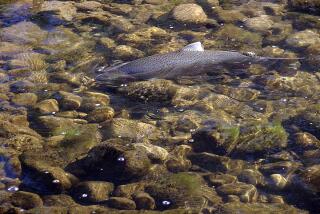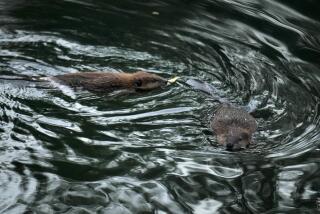Endangered frog makes a remarkable leap toward recovery

Southern California’s mountain yellow-legged frog has made a remarkable leap toward recovery for an endangered species, rebounding in just two years from near-extinction brought on by development, fires, fungal infections and predatory trout, federal biologists said on Monday.
In 2010, only 200 remained in isolated wild populations, prompting federal wildlife authorities and zoos in Fresno, Los Angeles and San Diego to launch an ambitious recovery program that included captive breeding facilities, trout removal programs and barring public access to areas where frogs were clinging to existence.
Last week’s reintroduction of 100 captive-bred juveniles to Indian Creek at the James San Jacinto Mountains Reserve in Riverside County brought the total number of wild frogs scientists know as Rana muscosa to roughly 1,000, according to Robert Fisher, a research biologist with the U.S. Geological Survey.
“These frogs still occupy only about 5% of their historic range,” Fisher said. “But we do not believe the mountain yellow-legged frog will go extinct within the next decade, which is the steep slope this species was on.”
About 25% of the frogs released into Indian Creek were outfitted with radio transmitters, Jennifer Gee, director of the James San Jacinto Mountains Reserve, said. “Their signals, which are monitored nearly every day, are providing valuable information about the species’ behavior,” she said.
Saving the mountain yellow-legged frog from extinction has not been easy. For example, biologists at the San Diego Zoo’s Institute for Conservation Research lost track of 36 tadpoles they had released in 2010 into Indian Creek.
However, biologists a week ago discovered two froglets in the stream; survivors of the earlier reintroduction effort.
“That discovery was a big deal for us,” said Jane Hendron, a spokeswoman for the U.S. Fish and Wildlife Service. “It gives us hope that we are going to see this species regain a more secure foothold in Southern California’s mountains.”
In May, the partnership effort to recover the mountain yellow-legged frog was recognized by the California Transportation Foundation as the Sustainable Environmental Enhancement Project of the Year.
Caltrans has provided funding for ongoing captive breeding programs at the San Diego Zoo institute and the Los Angeles Zoo and Botanical Gardens as mitigation for an emergency road repair project on State Route 330.
Since 2011, the San Diego institute has reared about 300 frogs and the Los Angeles Zoo has produced 210.







